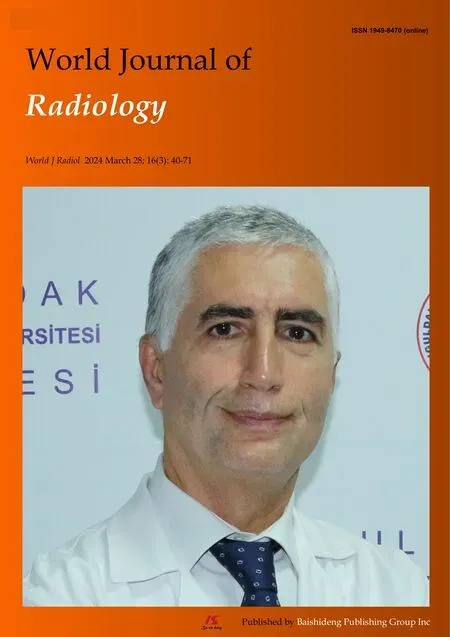Artificial intelligence for disease diagnostics still has a long way to go
Jian-She Yang,Qiang Wang,Zhong-Wei Lv
Abstract Artificial intelligence (AI) can sometimes resolve difficulties that other advanced technologies and humans cannot.In medical diagnostics,AI has the advantage of processing figure recognition,especially for images with similar characteristics that are difficult to distinguish with the naked eye.However,the mechanisms of this advanced technique should be well-addressed to elucidate clinical issues.In this letter,regarding an original study presented by Takayama et al,we suggest that the authors should effectively illustrate the mechanism and detailed procedure that artificial intelligence techniques processing the acquired images,including the recognition of non-obvious difference between the normal parts and pathological ones,which were impossible to be distinguished by naked eyes,such as the basic constitutional elements of pixels and grayscale,special molecules or even some metal ions which involved into the diseases occurrence.
Key Words: Artificial intelligence;Figure recognition;Diagnosis;AI interactive mechanisms
TO THE EDlTOR
Recently,Takayamaet al[1] reported that a branch of artificial intelligence (AI),namely,deep learning (DL),combined with reduced-field-of-view (reduced-FOV) diffusion-weighted imaging,which was identified as field-of-view optimized and constrained undistorted single-shot,has greatly improved image quality without prolonging the scan time for pancreatic cystic lesion diagnostics.
This is an very interested work related the current hot-topic,while,due to the technical shortages,further investigation need to be done during the near future.In terms of these issues,the authors haven’t outlined and addressed it in this work rationally.Here we presented some of shortcomings.
In this work,authors have applied the artificial intelligence to distinguish the images for identified diagnosis of pancreatic disease from other related or concurrent diseases,they should also analyze all types of pancreatic images by this technique as systematically as possible.Given the variety of diseases,even the physiological status of pancreatic disease can present diverse physical and chemical characteristics,which are the bases on which AI operates.However,by simply applying the commercial AIR? Recon DL algorithm (GE Healthcare),the authors have not provided readers the essential and enough information which mentioned above,even in the form of a supplementary material.A complete work should describe the phenomenon with its potential mechanism.Though the AI basic procedures and regulations have been well established by scientists,this interactive episode was absent in this study.
AI can sometimes resolve difficulties that other advanced technologies and humans cannot[2,3].The authors should effectively illustrate the mechanism and detailed procedure that artificial intelligence techniques processing the acquired images,including the recognition of non-obvious difference between the normal parts and pathological ones of pancreatic,which were not sensitive to naked eyes,such as the pixels and grayscale,special molecules or even some metal ions which involved into the diseases occurrence.All of these presentation will facilitate the understanding of AI processing and recognizing similar or confused images.These are the fundamental principles for artificial intelligence applying in medical use.
FOOTNOTES
Author contributions:Yang JS,Wang Q,and Lv ZW designed the research,analyzed the data and wrote the paper.
Supported bythe Dean Responsible Project of Gansu Medical College,No.GY-2023FZZ01;University Teachers Innovation Fund Project of Gansu Province,No.2023A-182;and Key Research Project of Pingliang Science and Technology,No.PL-STK-2021A-004.
Conflict-of-interest statement:All authors declare that the research was conducted in the absence of any commercial or financial relationships that could be construed as a potential conflict of interest.
Open-Access:This article is an open-access article that was selected by an in-house editor and fully peer-reviewed by external reviewers.It is distributed in accordance with the Creative Commons Attribution NonCommercial (CC BY-NC 4.0) license,which permits others to distribute,remix,adapt,build upon this work non-commercially,and license their derivative works on different terms,provided the original work is properly cited and the use is non-commercial.See: https://creativecommons.org/Licenses/by-nc/4.0/
Country/Territory of origin:China
ORClD number:Jian-She Yang 0000-0001-7069-6072;Qiang Wang 0000-0002-9855-6730;Zhong-Wei Lv 0000-0003-3370-5560.
S-Editor:Liu JH
L-Editor:A
P-Editor:Zhao S
 World Journal of Radiology2024年3期
World Journal of Radiology2024年3期
- World Journal of Radiology的其它文章
- Ductal carcinoma in situ within a fibroadenoma: A case report and review of literature
- Evaluating pediatric ureteropelvic junction obstruction: Dynamic magnetic resonance urography vs renal scintigraphy 99mtechnetium mercaptoacetyltriglycine
- Chronic pancreatitis: Pain and computed tomography/magnetic resonance imaging findings
